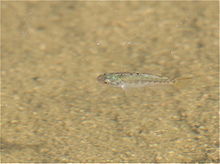- Cyprinodon macularius
-
Cyprinodon macularius 
female Conservation status Scientific classification Kingdom: Animalia Phylum: Chordata Class: Actinopterygii Order: Cyprinodontiformes Family: Cyprinodontidae Genus: Cyprinodon Species: C. macularius Binomial name Cyprinodon macularius
Baird and Girard, 1853Cyprinodon macularius is a rare species of fish in the family Cyprinodontidae and is known by the common name desert pupfish. It is a federally listed endangered species in the United States.
Presently, the only remaining natural populations of the desert pupfish are located at a few sites in the Salton Sea drainage in California, and the Colorado River Delta in Baja California and Sonora, Mexico.[1] The historic range of the desert pupfish included the lower Gila River basin in Arizona and Sonora, Mexico. It inhabited the Gila, Santa Cruz, San Pedro, and Salt Rivers as well as the lower Colorado River from around Needles, California, to the Gulf of California.
There are natural populations of this fish remaining in Arizona, however, populations have been introduced to several areas and some fish are kept in private ponds and aquaria.
The desert pupfish was once a common fish, but it is now extirpated from most of its historical natural range. The decrease in populations has been a trend since the early 1900s due to the loss of habitat. The desert pupfish is endangered due to habitat destruction and fragmentation. It has been, and continues to be, preyed upon and displaced by non-native fishes.
Contents
Habitat
The pupfish occupies shallow waters of springs, small streams, and marshes. It is often associated with areas of soft substrates and clear water.[2] It is adapted to variable water conditions and can live in warmer, saltier water than many other fish species.
Description
The body of the desert pupfish is thickened and markedly compressed laterally in adult males. The mouth is superior, highly protractile, armed with tricuspid teeth. The scales bear spine-like projections. The dorsal profile of the fish is smoothly rounded.
The body color of females and juveniles is silvery with narrow, vertical, dark bands known as parr marks on the sides, generally interrupted laterally to give the impression of a disjunct lateral band. The fins are generally colorless, with the exception of an ocellate spot on the dorsal, and rarely a dark spot on anal fin.[3] The male reaches a length of almost 3 inches (76 mm); the female is two-thirds that length. The breeding male develops an iridescent blue coloration with yellow or orange fins.[4]
Biology
Pupfish are capable of withstanding extreme environmental conditions, and are known to survive in water with low oxygen content, water temperatures over 35C (95F), and salinities almost 3 times that of sea water.[5]
The pupfish is omnivorous, feeding on aquatic invertebrates and plants. Breeding occurs mainly in the spring and the summer. The breeding male is fiercely territorial, each defending its turf against invasion by other males. Females that are ready to spawn will enter a male's territory. After spawning the male guards the nest. Periodically a subordinate male may sneak a dominant male's territory while the dominant male is busy chasing away other fish. The subordinate male may spawn with the female and then retreat to a safe place. The dominant male may therefore inadvertently protect eggs fertilized by another male.[6]
Management Factors
Threats to the species include alterations in local hydrology, such as draining of habitat by rerouting stream water, stream impoundment, and channelization. Other threats include pollution, livestock grazing, mining, logging, and fish stocking, which introduces non-native species. The pupfish is susceptible to displacement and predation by introducing fish.
Management of this rare fish requires protection of existing populations, studies of the gene pool of the remaining naturally occurring populations, reestablishment, and monitoring.[7] Refugia populations have been established in private ponds and aquariums. Reintroduction efforts have been made in natural and "quasi-natural" locations.[8]
See also
- Pupfish
- Cyprinodon - Genus
- Death Valley pupfish, Salt Creek pupfish, Cyprinodon salinus
- Shoshone Pupfish, Cyprinodon nevadensis shoshone
- Tecopa Pupfish, Cyprinodon nevadensis calidae (extinct)
- Owens pupfish ‘’Cyprinodon radiosus’’
- Devil's Hole pupfish ‘’Cyprinodon diabolis’’
- Category: Cyprinodon (Pupfish)
References
- ^ Minckley 1973, U.S. Fish and Wildlife Service [USDI, FWS] 1993).
- ^ USDI, Fish and Wildlife Service. 1993. Desert Pupfish Recovery Plan. Phoenix. pp.67.
- ^ Minckley, W.L. 1973. Fishes of Arizona. Arizona Game and Fish Department, Phoenix. pp. 186-192.
- ^ Rinne, John N. and W. L. Minckley. Native Fishes of Arid Lands: A Dwindling Resource of the Desert Southwest. Ft. Collins, CO: USDA Forest Service General Technical Report RM-206, 1991.
- ^ Minckley, W.L. 1973. Fishes of Arizona. Arizona Game and Fish Department, Phoenix. pp. 186-192.
- ^ Page, Lawrence M. and Brooks M. Burr. A Field Guide to Freshwater Fishes: North America North of Mexico. Boston: Houghton Mifflin, 1991.
- ^ Arizona Game and Fish Department. 2001. Cyprinodon macularius. Unpublished abstract compiled and edited by the Heritage Data Management System, Arizona Game and Fish Department, Phoenix, AZ. 3 pp.
- ^ Arizona Game and Fish Department. 2001. Cyprinodon macularius. Unpublished abstract compiled and edited by the Heritage Data Management System, Arizona Game and Fish Department, Phoenix, AZ. 3 pp.
External links
- Arizona Desert Museum: - Pupfish
- List of Arizona Native Fishes
- Froese, Rainer, and Daniel Pauly, eds. (2010). "Cyprinodon macularius" in FishBase. January 2010 version.
Categories:- IUCN Red List endangered species
- Cyprinodon
- Cave fish
- Fauna of Northern Mexico
- Fauna of the Colorado Desert
- Fauna of the Mojave Desert
- Fauna of the Sonoran Desert
- Fish of the Western United States
- Endemic fauna of the United States
- Colorado River
- Gila River
- Endangered fauna of California
- Endangered fauna of the United States
Wikimedia Foundation. 2010.

